Digital Posters
Relaxometry in the Brain: High Field & Multiparameter Mapping
ISMRM & SMRT Annual Meeting • 15-20 May 2021

| Concurrent 1 | 17:00 - 18:00 |
3045.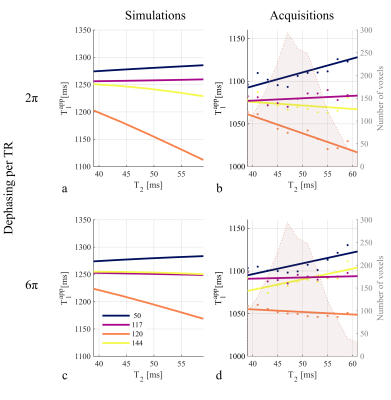 |
Residual T2 dependent bias of T1 times estimated with the Variable Flip Angle approach at 7T: Evaluation and recommendations.
Nadège Corbin1,2 and Martina F. Callaghan1
1Wellcome Centre for Human Neuroimaging, UCL Queen Square Institute of Neurology, University College London, London, United Kingdom, 2Centre de Résonance Magnétique des Systèmes Biologiques, UMR 5536, CNRS/University Bordeaux, Bordeaux, France
Imperfect spoiling introduces a bias in T1 times estimated with the Variable Flip Angle approach. Correction factors accounting for B1+ inhomogeneities have been proposed but a T2 dependent bias is expected to remain. Here we assess the amplitude of this effect at 7T with a commonly used multi-echo protocol and multiple radiofrequency spoiling increments and gradient spoiler moments. The T2 dependence is observed in-vivo and varies across spoiling conditions. Given that correction schemes don’t account for T2 variability, we recommend to use the least sensitive increment, such as 117° or 144°, in association with sufficient spoiling gradient (6π per TR).
|
|||
3046.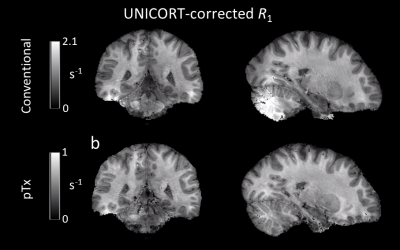 |
Parallel transmission for variable flip angle T1 mapping at 7T: initial experiences
Kerrin J Pine1, Nicolas Gross-Weege2, Martina F Callaghan3, and Nikolaus Weiskopf1,3,4
1Department of Neurophysics, Max Planck Institute for Human Cognitive and Brain Sciences, Leipzig, Germany, 2Siemens Healthcare GmbH, Erlangen, Germany, 3Wellcome Centre for Human Neuroimaging, UCL Queen Square Institute of Neurology, University College London, London, United Kingdom, 4Felix Bloch Institute for Solid State Physics, Faculty of Physics and Earth Sciences, Leipzig University, Leipzig, Germany
In this abstract we detail our first experiences using parallel transmission (pTx) to quantitatively map T1 via a dual flip-angle approach. We present data from a human volunteer scanned on the 7T Siemens MAGNETOM Terra using the pTx system and a Nova 32-channel receive / 8-channel transmit coil, with online optimized kT-points RF pulses. Data from the same coil in static CP mode (without pTx) was additionally acquired. With the demonstrated reduction in B1+ inhomogeneity, various bias correction schemes used at lower field strengths may become applicable.
|
|||
3047. |
High-resolution T2 maps of the whole brain at 7 Tesla: a proof of concept study using adiabatic T2-prepared FLASH and compressed sensing
Gabriele Bonanno1,2,3, Patrick Leibig4, Tobias Kober5,6,7, and Tom Hilbert5,6,7
1Advanced Clinical Imaging Technology, Siemens Healthcare AG, Bern, Switzerland, 2Translational Imaging Center, sitem-insel AG, Bern, Switzerland, 3Departments of Radiology and Biomedical Research, University of Bern, Bern, Switzerland, 4Siemens Healthcare GmbH, Erlangen, Switzerland, 5Advanced Clinical Imaging Technology, Siemens Healthcare AG, Lausanne, Switzerland, 6Department of Radiology, University Hospital (CHUV) and University of Lausanne (UNIL), Lausanne, Switzerland, 7LTS5, École Polytechnique Fédérale de Lausanne, Lausanne, Switzerland
T2 relaxometry has the potential to become an important quantitative MRI biomarker thanks to its sensitivity to pathology. However, acquiring high-resolution isotropic T2 maps is challenging due to signal-to-noise and specific absorption rate constraints. We present a T2-mapping method for ultra-high-field MRI based on an optimized T2-prepared acquisition with compressed sensing acceleration. The T2 preparation uses adiabatic pulses in conjunction with a segmented FLASH sequence to obtain uniform whole-brain T2 weighting despite B1 inhomogeneity. Preliminary tests show good signal homogeneity for images and maps obtained in a scan time compatible with volunteer studies.
|
|||
3048.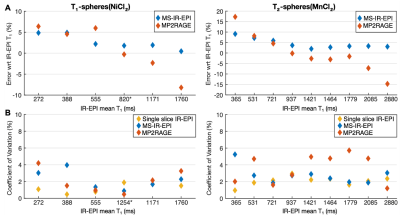 |
T1 mapping of the ISMRM/NIST system phantom at 7T.
Rosa Sanchez Panchuelo1, Olivier Mougin1, Robert Turner1,2, and Susan Francis1,3
1Sir Peter Mansfield Imaging Centre, UP, University of Nottingham, Nottingham, United Kingdom, 2Max Planck Institute for Human Cognitive and Brain Sciences, Leibzig, Germany, 3NIHR Nottingham Biomedical Research, University of Nottingham, Nottingham, United Kingdom
We report the quantitative T1 values of the NIST/ISMRM system phantom T1 and T2 spheres at 7T. We compare the accuracy and repeatability of T1 measurements using a 2D multi-slice multi-shot IR-EPI sequence, to 3D MP2RAGE and standard single-slice IR sequences at 3 and 7 T. We show that T1 measurements are more accurate using MS-IR-EPI compared to MP2RAGE. The T2-spheres of the NIST/ISMRM system phantom are shown to be best suited for T1-mapping at 7T as they offer a wider range of T1-values, better matched than those of the T1-spheres to those found within the human brain.
|
|||
3049.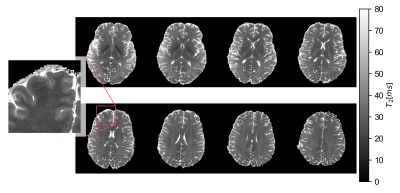 |
Quantification of transverse relaxation times in vivo at 7T field-strength.
Jochen Schmidt1, Dvir Radunsky2, Patrick Scheibe1, Noam Ben-Eliezer2,3,4, Nikolaus Weiskopf1,5, and Robert Trampel1
1Neurophysics, Max Planck Institute for Human Cognitive and Brain Sciences, Leipzig, Germany, 2Biomedical Engineering, Tel Aviv University, Tel Aviv, Israel, 3Sagol School of Neuroscience, Tel Aviv University, Tel Aviv, Israel, 4Center for Advanced Imaging Innovation and Research (CAI2R), New-York University Langone Medical Center, New York, NY, United States, 5Felix Bloch Institute for Solid State Physics, Faculty of Physics and Earth Sciences, Leipzig University, Leipzig, Germany
Accurate quantification of transverse relaxation times in vivo is of vital importance for research and clinical applications. At higher field-strength, the gain in signal enables T2 mapping at sub-millimetre resolutions, but with infeasible scan time for standard spin-echo techniques. Using CPMG echo trains reduces the acquisition time. However, inhomogeneities of the transmit B1 field hamper accurate T2 quantification. Correcting for resulting bias effects is possible through signal response simulations via the Bloch equations using the specific sequence parameters. Matching acquired data to the simulated signal points allows accurate and robust fitting of T2 values as shown by our 7T study.
|
|||
3050.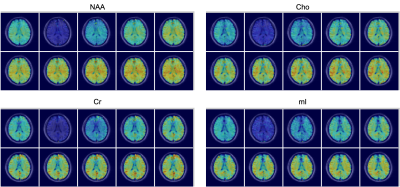 |
Simultaneous Mapping of Metabolite Concentration and T1 Relaxation Time Using Subspace Imaging Accelerated Inversion Recovery MRSI
Chao Ma1,2, Paul K. Han1,2, and Georges El Fakhri1,2
1Radiology, Massachusetts General Hospital, Boston, MA, United States, 2Radiology, Harvard Medical School, Boston, MA, United States
Absolution quantification of metabolite concentration requires accurate measurement of the longitudinal relaxation times of metabolites. However, it will be very time consuming to access the spatial variations of metabolite T1 relaxation times using the conventional MRS-based methods. Inspired by the recent success of the subspace-based methods for fast high-resolution MRSI, we propose a subspace imaging-based method for simultaneous mapping of metabolite concentration and T1 relaxation time. We propose a fast Look-Locker EPSI sequence for data acquisition and a low-rank tensor-based method for simultaneous reconstruction of MRSI images at different TIs.
|
|||
3051.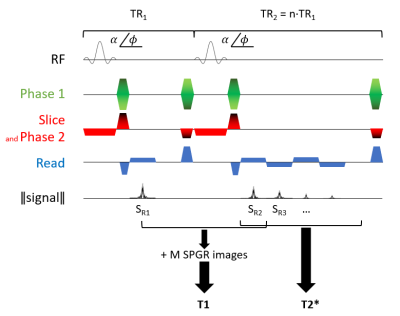 |
RAMSES: Relaxation Alternate Mapping of Spoiled Echo Signals sequence for simultaneous accurate T1 and T2* mapping
Marco Andrea Zampini1,2, Jan Sijbers3, Marleen Verhoye2, and Ruslan Garipov1
1MR Solutions Ltd, Guildford, United Kingdom, 2Department of Biomedical Sciences, University of Antwerp, Wilrijk, Belgium, 3Department of Physics, University of Antwerp, Wilrijk, Belgium
Fast multiparametric mapping could ease the adoption of quantitative MRI in clinical practice. We propose a new 3D sequence (RAMSES) which toggles the readout modality between mono- and multi-gradient echo that, associated with the acquisition of one or several spoiled gradient echo images, can provide maps of T1, T2*, B1 and net magnetisation, M0. Results show the feasibility of RAMSES for accurate and precise relaxometry mapping within a clinically reasonable acquisition time.
|
|||
3052.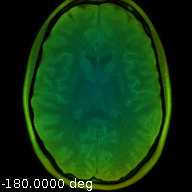 |
Fast-Sweep Frequency-Modulated SSFP: Boosting Sensitivity for 3D Joint T1/T2 Mapping
Volkert Roeloffs1, Nick Scholand1,2, and Martin Uecker1,2,3
1Institute for Diagnostic and Interventional Radiology, University Medical Center Göttingen, Goettingen, Germany, 2DZHK (German Centre for Cardiovascular Research), Partner Site Göttingen, Germany, Goettingen, Germany, 3Campus Institute Data Science (CIDAS), University of Göttingen, Göttingen, Germany, Goettingen, Germany
Sensitivity to T1 and T2 in frequency-modulated SSFP sequences can be increased by choosing a higher modulation speed without prolonging the repetition time. In this work, we assess the boost in sensitivity by Cramér-Rao-bound analysis, combine the sequence with stack-of-stars sampling and subspace-constrained reconstruction, and demonstrate joint T1/T2/B1/off-resonance mapping in phantom and in vivo study. The results render fast-sweep frequency-modulated SSFP an excellent candidate for comprehensive 3D multi-parametric mapping.
|
|||
3053.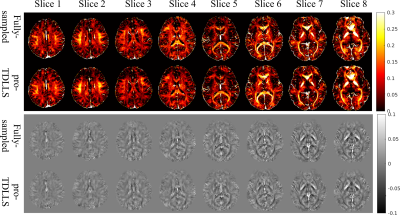 |
Simultaneous Mapping of Myelin Water Fraction and Quantitative Susceptibility of Whole Brain
Quan Chen1, Huajun She1, Ming Zhang1, Hongjiang Wei 1, and Yiping P. Du1
1Shanghai Jiao Tong University, Shanghai, China
The feasibility of simultaneously obtaining the quantitative myelin water fraction (MWF) mapping and susceptibility mapping (QSM) is demonstrated by using the multi-echo gradient echo (mGRE) sequence in this study. The retrospective and the perspective undersampling experiments have shown the potential of obtaining whole brain QSM/MWF quantifications in 1 minute.
|
|||
3054.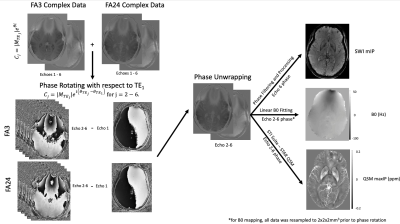 |
Two multi-echo SPGR acquisitions for the simultaneous generation of SWI, qT1 and other parametric maps: preliminary data
Vishaal Sumra1,2, Tobias C Wood3, and Sofia Chavez1,2
1Institute of Medical Science, University of Toronto, Toronto, ON, Canada, 2Brain Health Imaging Centre - MRI, Centre for Addiction and Mental Health, Toronto, ON, Canada, 3Department of Neuroimaging, King's College London, London, United Kingdom
Multi-parametric mapping is often conducted using multiple separate scans, leading to errors in registration and long scan times. Multi-echo complex data was acquired for two flip angles, with a total scan time of 11 minutes at high resolution. Optimized processing allowed for the generation of high resolution qT1, R2*, QSM, SWI and B0 maps in the same space. The use of all echoes in processing, as well as long maximum TE allows for improvements in image quality. Future studies will investigate optimizing phase processing to further improve image quality while decreasing scan time.
|
|||
3055.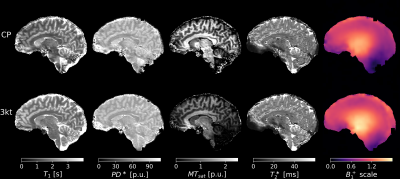 |
Optimization of fast Quantitative Multiparameter Mapping (MPM) at 7T using parallel transmission
Difei Wang1, Rüdiger Stirnberg1, Eberhard Pracht1, and Tony Stöcker1,2
1German Centre for Neurodegenerative Diseases (DZNE), Bonn, Germany, 2Department of Physics and Astronomy, University of Bonn, Bonn, Germany
We propose a fast MPM protocol at 7T using skipped-CAIPI 3D-EPI with simple PTx water-excitation based on 3 kT-points. By comparison to corresponding CP mode scans, the 3 kT-points excitation mainly improves the B1+ field homogeneity in the Cerebellum. Using MPM B1+ field correction, this simple improvement is sufficient to achieve good and homogeneous T1, PD and T2* estimates throughout the brain. However, the lack of MT homogenization still results in the inadequate MTsat CNR. By combining MPM with EPI and PTx, we obtained quantitative whole-brain parameter maps of high quality, except for Cerebellar MTsat within 3 minutes scan time.
|
|||
3056.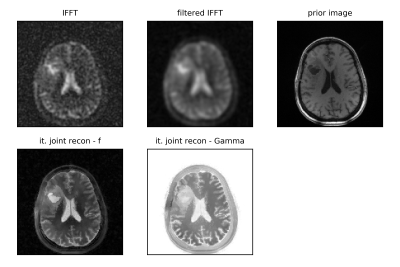 |
Joint sodium MR reconstruction and T2* estimation using anatomical regularization
Georg Schramm1, Johan Nuyts1, and Fernando Boada2
1KU Leuven, Leuven, Belgium, 2New York University School of Medicine, New York City, NY, United States
The image quality in sodium MR is hampered by very fast T2* decay during readout and high levels of noise in the acquired data. In this work we propose a joint iterative framework, including signal decay modeling during readout and decay estimation, to reconstruct dual echo sodium MR data. Regularization is incorporated by using an anatomical prior based on a high-resolution hydrogen T1 image. In simulations and a real brain tumor data set acquired on a 3T MR we demonstrate that our framework allows to suppress noise while preserving anatomical detail.
|
|||
3057. |
Simultaneous T1, T2*, and Apparent Diffusion Coefficient Mapping with Stimulated Multi-Echo-Train EPI
Guangyu Dan1,2, Kaibao Sun1, Qingfei Luo1, and Xiaohong Joe Zhou1,2,3
1Center for MR Research, University of Illinois at Chicago, Chicago, IL, United States, 2Department of Bioengineering, University of Illinois at Chicago, Chicago, IL, United States, 3Departments of Radiology and Neurosurgery, University of Illinois at Chicago, Chicago, IL, United States
A growing number of clinical applications rely on quantitative mapping of relaxation times and apparent diffusion coefficient (ADC). In addition, research interest in understanding the interplay between relaxation and diffusion processes is rising. Conventional methods for mapping relaxation and diffusion parameters require separate scans, resulting in not only a long acquisition time but also image co-registration challenges when inter-scan motion is present. We herein report a stimulated multi-echo-train EPI sequence with diffusion-weighting to achieve simultaneous, co-registered T1, T2* and ADC mapping. This technique was implemented at 3T and demonstrated in the brain and the prostate of healthy human subjects.
|
|||
3058.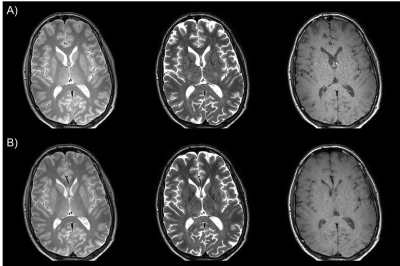 |
Ultra-high Spatial Resolution Multispectral qMRI with Compressed Sensing Tri-TSE
Ryan McNaughton1, Hernan Jara1,2, Ning Hua2,3, Andy Ellison2,3, Lee Goldstein1,2,3, and Stephan Anderson2,3
1Boston University, Boston, MA, United States, 2Boston University Medical Center, Boston, MA, United States, 3Center for Translational Neuroimaging, Boston, MA, United States
Purpose: To test the PD-T1-T2 qMRI accuracy of ultra-high spatial resolution compressed sense Tri-TSE. Methods: A healthy male volunteer (35yo) was scanned with an ultra-high spatial resolution compressed sensing Tri-TSE pulse sequence. Maps of PD, T1, and T2 were generated with voxel size of 0.4 x 0.4 x 1.2 mm3. Results: PD, T1, and T2 accuracy are not affected by threefold compressed sensing acceleration. Conclusion: Compressed sensing does not appear to negatively impact MS-qMRI accuracy and opens the door to ultrafast brain MS-qMRI at current clinical spatial resolution or to a new high spatial resolution standard in the clinical context.
|
|||
3059.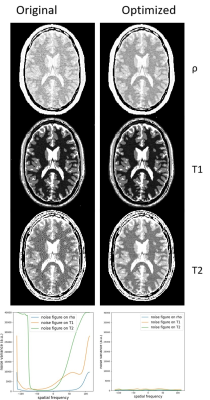 |
BLAKJac - A computationally efficient noise-propagation performance metric for the analysis and optimization of MR-STAT sequences
Miha Fuderer1,2, Oscar van der Heide1,2, Cornelis A. T. van den Berg1,2, and Alessandro Sbrizzi1,2
1Computational Imaging Group for MR Diagnostics and Therapy, Center for Image Sciences, University Medical Center Utrecht, Utrecht, Netherlands, 2Department of Radiology, Division of Imaging and Oncology, University Medical Center Utrecht, Utrecht, Netherlands
In MR-STAT, data from a sequence of time-varying RF pulses and gradient encodings is reconstructed into multiple quantitative parameter maps by solving a large scale inversion problem. The combined interaction of RF and gradient events determines the noise-propagation into the reconstructed maps. We derive a computationally efficient performance metric to study this effect, by analyzing the block-diagonal of the k-space representation of the Jacobian. This allows for extremely fast prediction of the noise spectrum of the reconstructed parameter maps.
|
|||
3060.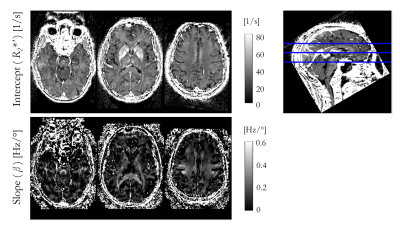 |
Characterisation of the flip angle dependence of R2* in Multi-Parameter Mapping
Giorgia Milotta1, Nadège Corbin1,2, Christian Lambert1, Antoine Lutti3, Siawoosh Mohammadi4,5, and Martina Callaghan1
1Wellcome Centre for Human Neuroimaging, UCL Queen Square Institute of Neurology, University College London, London, United Kingdom, 2Centre de Résonance Magnétique des Systèmes Biologiques, UMR5536, CNRS/University Bordeaux, Bordeaux, France, 3Laboratory for Research in Neuroimaging, Department for Clinical Neuroscience, Lausanne University Hospital and University of Lausanne, Lausanne, Switzerland, 4Department of Systems Neurosciences, University Medical Center Hamburg-Eppendorf, Hamburg, Germany, 5Department of Neurophysics, Max Planck Institute for Human Cognitive and Brain Sciences, Leipzig, Germany
The apparent transverse relaxation rate (R2*) has biologically-relevant dependence on iron content and myelination. However confounding factors, e.g. flip angle dependence owing to differential longitudinal relaxation rates of sub-compartments, hinder interpretation. Multi-compartment models have been used to estimate myelin-water fraction from multi-echo spoiled GRE images, but require rich datasets for reliable estimation leading to extended acquisition times. A time-efficient alternative is to assume mono-exponential intra-voxel decay. In this work, we characterise the residual FA-dependence of such R2* estimates in vivo, and explore the biological origin of this dependence via simulations.
|
|||
3061.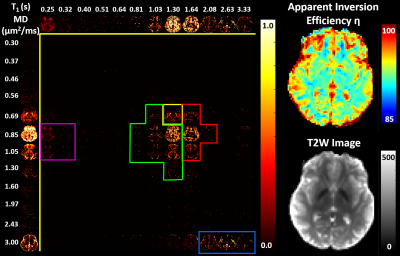 |
Mapping correlation spectra of T1 and mean diffusivity in the human brain
Alexandru V Avram1,2, Joelle E Sarlls3, and Peter J Basser1
1Eunice Kennedy Shriver National Institute of Child Health and Human Development, National Institutes of Health, Bethesda, MD, United States, 2Center for Neuroscience and Regenerative Medicine, The Henry Jackson Foundation, Bethesda,, MD, United States, 3National Institute of Neurological Disorders and Stroke, National Institutes of Health, Bethesda, MD, United States
We develop a novel clinical pulse sequence with integrated inversion recovery (IR) and isotropic diffusion encoding (IDE) preparations for mapping correlation spectra of subvoxel T1 and mean diffusivities (MD) from measurements acquired with a wide range of joint T1-MD weightings. We evaluated the performance of the pulse sequence and spectral reconstruction pipeline using data from numerical simulations, a calibrated MRI phantom and healthy volunteers. Preliminary results suggest that maps of subvoxel T1-MD spectra show tissue-specific components in the human brain. Quantifying the heterogeneity of T1-diffusion properties in microscopic water pools could improve biological specificity in many clinical applications.
|
|||
3062.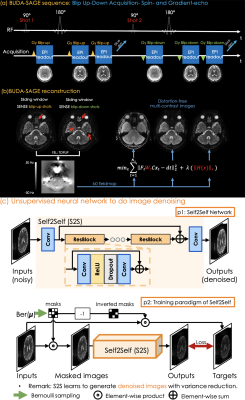 |
BUDA-SAGE with unsupervised denoising enables fast, distortion-free, high-resolution T2, T2*, iron and myelin susceptibility mapping
Zijing Zhang1,2, Long Wang3, Hyeong-Geol Shin4, Jaejin Cho2, Tae Hyung Kim2, Jongho Lee4, Jinmin Xu1, Tao Zhang3, Huafeng Liu1, and Berkin Bilgic2
1State Key Laboratory of Modern Optical Instrumentation, College of Optical Science and Engineering, Zhejiang University, Hangzhou, China, 2Department of Radiology, A. A. Martinos Center for Biomedical Imaging, Massachusetts general hospital, Boston, MA, United States, 3Subtle Medical Inc, Menlo Park, CA, United States, 4Laboratory for Imaging Science and Technology (LIST), Department of Electrical and Computer Engineering, Seoul National University, Seoul, Korea, Republic of
We propose BUDA-SAGE, an efficient echo‐planar imaging (EPI) sequence for quantitative mapping. The acquisition includes multiple T2*-, T2’- and T2-weighted contrasts. We alternate the phase-encoding polarities across the shots in this multi-shot navigator-free acquisition to eliminate geometric distortion. An unsupervised Self2Self (S2S) neural network (NN) was utilized to perform denoising after BUDA reconstruction to achieve 1×1×2 mm3 resolution with high SNR. We demonstrate the ability of BUDA-SAGE to provide whole-brain, distortion-free, high-resolution multi-contrast images and quantitative T2, T2* maps in 50 seconds, and separate para- and dia-magnetic susceptibility maps in 140 seconds.
|
|||
3063. |
Faster Bloch simulations and MR-STAT reconstructions on GPU using the Julia programming language
Oscar van der Heide1,2, Alessandro Sbrizzi1,2, and Cornelis van den Berg1
1Computational Imaging Group for MR Diagnostics and Therapy, Center for Image Sciences, University Medical Center Utrecht, Utrecht, Netherlands, 2Department of Radiology, Division of Imaging and Oncology, University Medical Center Utrecht, Utrecht, Netherlands MR-STAT is a multi-parametric quantitative MR framework with computationally demanding reconstructions. In this work we implemented the reconstruction algorithm on the GPU using the Julia programming language, a language that allows for quick prototyping without sacrificing on performance. We demonstrate superior runtime-performance of the GPU implementation as compared to previously proposed implementations running on a cluster of CPU's. With the proposed implementation, high-resolution in-vivo parameter maps can be reconstructed in approximately two minutes. The proposed implementation can also be used to rapidly generate MR Fingerprinting dictionaries and is shown to outperform the native CUDA implementation from SnapMRF.
|
|||
3064.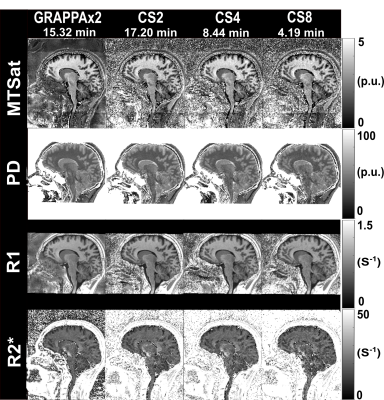 |
Compressed sensing for accelerated multi-parameter quantitative MRI
Arun Joseph1,2,3, Quentin Raynaud4, Antoine Lutti4, Tobias Kober5,6,7, and Tom Hilbert5,6,7
1Advanced Clinical Imaging Technology, Siemens Healthcare AG, Bern, Switzerland, 2Translational Imaging Center, Sitem-Insel, Bern, Switzerland, 3Departments of Radiology and Biomedical Research, University of Bern, Bern, Switzerland, 4Laboratory for Neuroimaging Research, Department for Clinical Neuroscience, Lausanne University Hospital and Lausanne University, Lausanne, Switzerland, 5Advanced Clinical Imaging Technology, Siemens Healthcare AG, Lausanne, Switzerland, 6Department of Radiology, Lausanne University Hospital and University of Lausanne, Lausanne, Switzerland, 7LTS5, École Polytechnique Fédérale de Lausanne (EPFL), Lausanne, Switzerland
Quantitative MRI (qMRI) provides biomarkers of microstructural properties of brain tissue and enables in-vivo monitoring of microscopic brain changes due to disease in patient populations. The widely used Multi Parameter Mapping qMRI protocol allows the computation of MTSat, PD, R1, and R2* maps. While it allows the assessment of multiple brain tissue properties, its acquisition time is excessive for clinical applications. Here, we propose a compressed sensing scheme based on a Cartesian spiral-phyllotaxis readout to reduce the total acquisition time of 1mm isotropic whole brain maps. A preliminary qualitative and quantitative validation is performed on healthy subjects.
|
The International Society for Magnetic Resonance in Medicine is accredited by the Accreditation Council for Continuing Medical Education to provide continuing medical education for physicians.